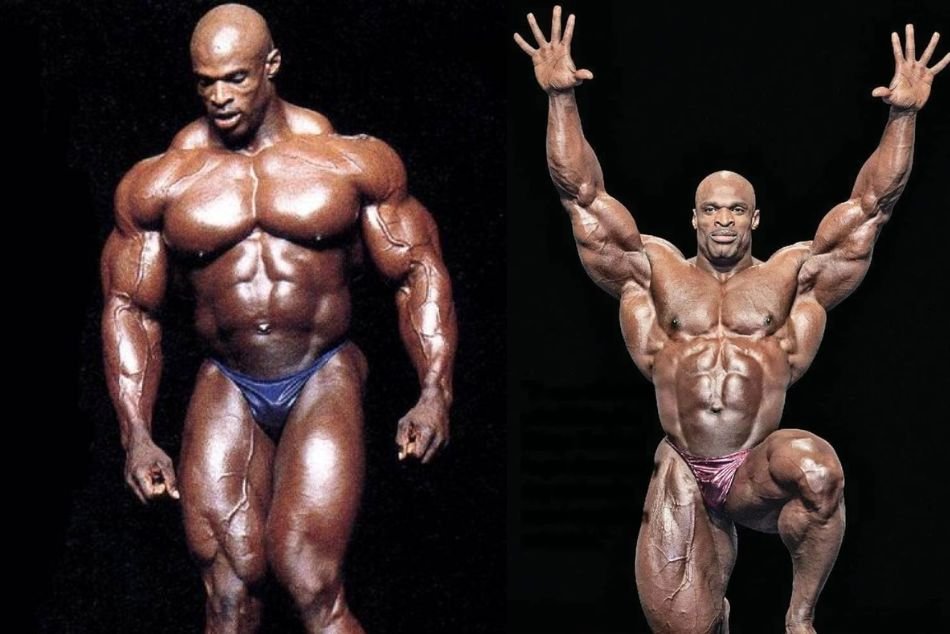Ronnie Coleman Tips to Train Like a True Bodybuilding Legend
Ronnie Coleman didn’t just redefine what it meant to be a bodybuilder—he redefined the limits of human strength and discipline. His success wasn’t luck, genetics, or hype; it was built on years of relentless work and a mindset that refused to settle for “good enough.” Even after winning eight consecutive Mr. Olympia titles, when people asked if he’d do anything differently, his answer said it all: “I’d train harder.”
That single line sums up the core of Ronnie Coleman tips—push past your limits, stay consistent, and never let fear of pain or fatigue hold you back. His approach to training was a mix of heavy compound lifts, strict form, and a deep understanding of how the body grows. What made him different wasn’t just the weight he lifted but the way he connected his mind to every rep, every contraction, every burn.
If you’ve ever wanted to learn the mindset and methods behind “The King,” these Ronnie Coleman bodybuilding tips will help you see training from the perspective of one of the most dominant athletes in history.

1. Dumbbell Presses Are King for Chest Mass
Coleman’s chest wasn’t built on machines or cables—it was built under dumbbells and barbells. He swore by the freedom and balance dumbbells provide, forcing both sides of the chest to work equally. Unlike a barbell, dumbbells don’t allow one side to assist the other; each pec must lift its own load.
This independence develops balance, symmetry, and full contraction. Ronnie often rotated between flat, incline, and decline dumbbell presses and mixed in barbell work for variety. But the principle stayed the same: go as heavy as possible with clean form and a full range of motion.
Among all ronnie coleman tips, this one stands out for its simplicity—dumbbell presses should be the foundation for anyone chasing serious pec growth. If your goal is dense, round chest development, prioritize dumbbells before machines or cables.
2. You Can’t Just Shrug for Great Traps
Most lifters think traps grow only from shrugs. Ronnie knew better. Traps are surrounded by several other muscle groups that absorb tension—lats, rhomboids, delts, and erectors—making them hard to isolate.
Shrugs alone don’t provide enough movement through multiple planes to fully stimulate the traps. Coleman’s workout tips for traps included heavy deadlifts, barbell rows, T-bar rows, power cleans, and upright rows. These compound moves force your traps to stabilize massive loads from different angles.
The takeaway from this Ronnie Coleman bodybuilding tip is to train your traps dynamically. Think of them as a bridge between your upper back and shoulders that must be hit from every angle, not just the straight-up shrug motion.
3. Get Lean Without Losing Strength
Many lifters believe cutting means dropping strength. Ronnie completely disagreed. He argued that as you reduce body fat, your muscle-to-weight ratio improves, giving you greater endurance and control.
Coleman’s method was to keep training heavy, even when dieting down for competition. He didn’t believe in switching to high reps with light weights. Instead, he stuck to his core lifts, maintained protein intake, and carefully adjusted calories so that fat burned away—but muscle stayed.
Among all Ronnie Coleman workout tips, this one challenges one of bodybuilding’s biggest myths: losing fat doesn’t mean losing power. Stay heavy, stay intense, and let your nutrition—not your training volume—create the deficit.
4. Don’t Neglect the Rear Delts
Rear delts are one of the most stubborn muscle groups to grow. They’re hard to isolate and easy to overlook. Coleman’s strategy was to treat them as a priority muscle group, not a finishing touch.
He visualized every rep before performing it, focusing on how the rear delts rotated through the movement rather than letting traps or lats take over. His go-to exercises were seated dumbbell laterals (chest braced on an incline) and seated dumbbell presses with back support.
To build a complete, three-dimensional shoulder, follow this Ronnie Coleman tip: train your rear delts first or at least when you still have energy. It’s the difference between a good physique and one that looks powerful from every angle.
5. Dumbbells for Triceps Isolation
Coleman’s triceps training always included dumbbells. They allowed him to target all three heads individually, something cables or barbells couldn’t fully achieve.
He often used four exercises per workout—two overhead movements (like seated French curls and behind-the-neck extensions) and two front/downward moves (such as close-grip bench presses or dips). He didn’t stick to a fixed order; sometimes he began with isolation work and ended with mass movements, sometimes the reverse.
The key takeaway: variety and intensity matter more than order. Alternate between mass and isolation lifts to create that deep, burning fatigue Ronnie always chased. Among all Ronnie Coleman bodybuilding tips, this one shows how free weights can give you both control and size in a single workout.
6. Time and Intensity Matter More Than Duration
Ronnie didn’t believe in counting minutes; he believed in counting effort. A short, intense session beats a long, lazy one every time. His approach was simple: the harder you train, the faster you’ll fatigue the target muscle—and the shorter your workout should be.
Smaller muscles like biceps or shoulders reach fatigue faster than larger ones like legs or back. But Ronnie warned not to confuse volume with effort. Adding more sets doesn’t automatically mean more growth if the intensity isn’t there.
This is one of those Ronnie Coleman workout tips that applies to every level of training: focus on making every set count. Don’t let your workouts become time fillers—make them performance sessions.
7. Chase the Pump
The “pump” was more than a feeling for Ronnie—it was feedback. A tight, blood-filled muscle meant you were on the right track. Heavy weight was important, but only if it created a pump.
Coleman would start with a weight he could lift for 12 solid reps, then increase gradually until the pump peaked. The goal was always the same: fill the muscle as much as possible with blood, nutrients, and oxygen. He adjusted reps and weight until he found that sweet spot.
This mindset is at the heart of all Ronnie Coleman tips—listen to your body’s response. If the muscle isn’t pumped, it’s not being challenged. Train heavy, but chase the feeling of fullness that tells you the muscle has truly been worked.
8. Build Super Quads With Supersets
No one who saw Ronnie’s legs could ever forget them. His quads were massive, detailed, and dense. His secret? Supersetting.
He would pair movements like leg presses and squats, or extensions and hacks, to create back-to-back tension on the same muscle group. This kept constant blood flow in the quads, creating an unmatched pump and burn.
Coleman advised against supersetting opposing muscles like quads and hamstrings if your goal is to build maximum pump and volume in one area. Stick to pairing quad exercises together for maximum growth.
This is one of the more demanding Ronnie Coleman bodybuilding tips, because supersets require cardio-level endurance and mental grit. But for building brutal leg size, nothing compares.
9. The Power of Pressing for Complete Shoulder Growth
For Ronnie, the military press was non-negotiable. It was the purest compound movement for shoulder width and density. He alternated between seated presses (to isolate delts) and standing presses (to engage the entire body).
Pressing in front of the head hits all major deltoid heads while keeping stress balanced across the shoulder girdle. He considered it the foundation for a strong upper body and an absolute must for anyone chasing size and structure.
Among Ronnie Coleman workout tips, this one might be the simplest: keep pressing. If you want wide, thick shoulders that can handle anything, make the military press your main lift.
10. The Perfect Number of Reps Doesn’t Exist
Coleman never followed strict rep counts. He believed in experimenting until he found the ideal combination of weight and reps that produced the best pump. For some muscles, that could be 6 reps; for others, 15.
He often started with 12 reps to gauge the pump, then adjusted accordingly. If a heavier weight reduced the pump, he backed off. If lighter weight created better fullness, he stayed there until strength increased.
This flexible approach might be the most valuable of all Ronnie Coleman tips—training isn’t math, it’s feel. Learn your body. The goal is progress, not just numbers on a page.
The Mindset Behind the Muscle
Ronnie’s training principles weren’t just physical—they were mental. He believed that how you think determines how far your body can go. Every lift was treated like a challenge, every set a test of will.
His legendary work ethic wasn’t fueled by ego, but by love for the process. Even his famous catchphrases—“Yeah buddy!” and “Light weight!”—weren’t just hype; they were self-commands to push harder, stay focused, and enjoy the grind.
In today’s era of shortcuts and influencer advice, these Ronnie Coleman bodybuilding tips remain timeless. They remind you that progress comes from consistency, effort, and faith in the basics.
Conclusion: Living by the Ronnie Coleman Tips
The legacy of Ronnie Coleman isn’t just about trophies or numbers—it’s about attitude. He trained harder than everyone else, stayed humble, and never backed off from discomfort. Whether you’re a beginner or seasoned lifter, these Ronnie Coleman tips hold the blueprint for long-term growth.
Apply them with patience and intensity. Focus on dumbbell work, train traps with compound lifts, chase the pump, and never stop testing your limits. Keep your nutrition solid, your recovery consistent, and your mindset unbreakable.
When you train with that kind of purpose, you’re not just following Ronnie Coleman workout tips—you’re adopting the mentality of a champion. As Ronnie himself said best: “Everybody wants to be a bodybuilder, but nobody wants to lift no heavy-ass weights.” The King’s words still ring true today, and if you live by them, you’ll understand why his legend will never fade.






